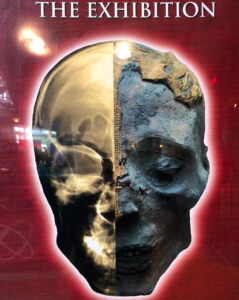
Poster at St. Louis Science Center. Photo by John Griswold
“Hot damn, mummies!” I heard someone say at the St. Louis Science Center, which is currently hosting the exhibit Mummies of the World. Who is not drawn to gaze on a mummy, even at $19.95 a ticket?
Usually I think of mummies as “ceremonially preserved,” but this exhibit takes the more accurate, broader view that they are any animal bodies desiccated by salt, tannins, other chemicals, cold, low humidity, or low oxygen levels, whether done intentionally or not.
Accordingly the exhibit contains “40 real human and animal mummies and 85 rare artifacts from across the globe, providing a window into the lives of people from every region of the world and offering unprecedented insights into past cultures and civilizations. This compelling collection, presented with reverence and dignity, includes ancient mummies from South America, Europe and ancient Egypt, dating as far back as 4,500 years.”
The reverence and dignity was being upheld, starting at the ticket booth, where the young woman delivered the same stern lecture to every visitor: no photos and no disrespectful behavior, since some of the mummies had living relatives who, it was implied, would be very upset if the bodies were objectified.
As it turns out, the only mummy identified in the exhibit with living relatives aware of its existence is Baron von Holz, who died in the 17th century. He is a relative of the Crailsheim family, whose ancestors were mummified, without being embalmed, in the crypt at Schloss Sommersdorf, in Bavaria.
Baron Manfred and Baroness Lilo von Crailsheim are the current owners of the castle, in a line going back to 1550. They agreed to scientific analysis and the traveling display of their distant relative. It has to be said that if reverence and dignity are the main concerns, the Baron and Baroness put the mummies of their family on their website, where they also offer hotel stays in their castle, picnics, “wedding excursions,” a medieval market, vintage car shows on the grounds, an exhibition of the current Baron’s own car collection, and easy access to beer gardens, breweries, festivals, “amusement parks, climbing parks and water sports nearby for children’s entertainment.”
“Live the Fantasy,” the Crailsheim’s site says.
Among the photos and illustrations of their mummified kin is a statement that makes my empirical method hurt: “In connection with the exhibition Mummies of the World…extensive investigations of the Sommersdorf mummies was carried out in 2007. The scientists came to the conclusion that mummification is caused by the drying of tissue.”
Little kids were swarming around the Baron von Holz at top speed—he is protected in a glass box—and a young docent pointed out that his corpse was still wearing rakish cuffed boots.
“Making the skin on his face last was just like preserving his leather boots,” she said. (His boots are in better shape than he is.)
Historically, the Baron and other mummies at Sommersdorf have not exactly rested in peace. For more than 200 years, starting with Napoleonic soldiers in 1806, their coffins have been periodically pried open, and they have been gazed upon and handled.
There is always a whiff of the sideshow about mummy exhibits, as there was in uncovered Paleo-Indian graves on the Ohio River when I was a kid, or in the odd posings of plastinated corpses by Dr. Gunther von Hagens, who insists his exhibitions are educational, not sensationalistic.
In a corner of the Science Center’s mummy exhibit, where “shrunken heads” were displayed in low light, a docent walked up and pretended to shiver. “They just freak me out,” she said. “So gross.”
The present did not invent cultural insensitivity. Mummies have always been sold as souvenirs—often in pieces—been ground up for medicinal powders, displayed to gawkers, and put to use in medical study.
The fascination is always there, and maybe it should be. Mummies survive the ages and hint at a kind of immortality. All it took was for them to be stripped of the water that is 60% of who we are and deprived of the oxygen necessary for life. These leathers in rags bear resemblance to the living beings they were, but we miss the point: Without those things, we are nothing.
